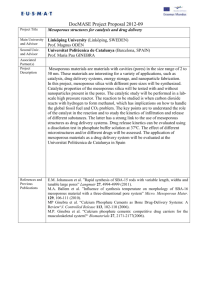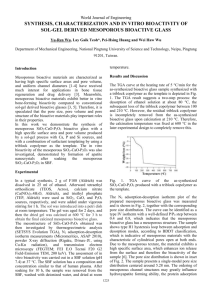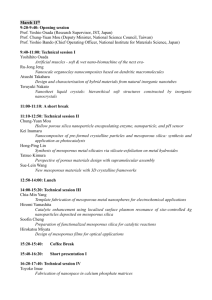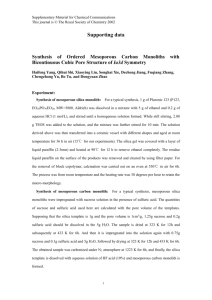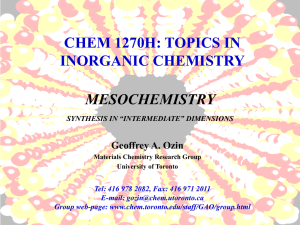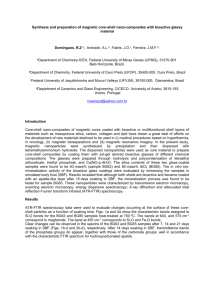World Journal of Engineering Synthesis and characterization of
advertisement
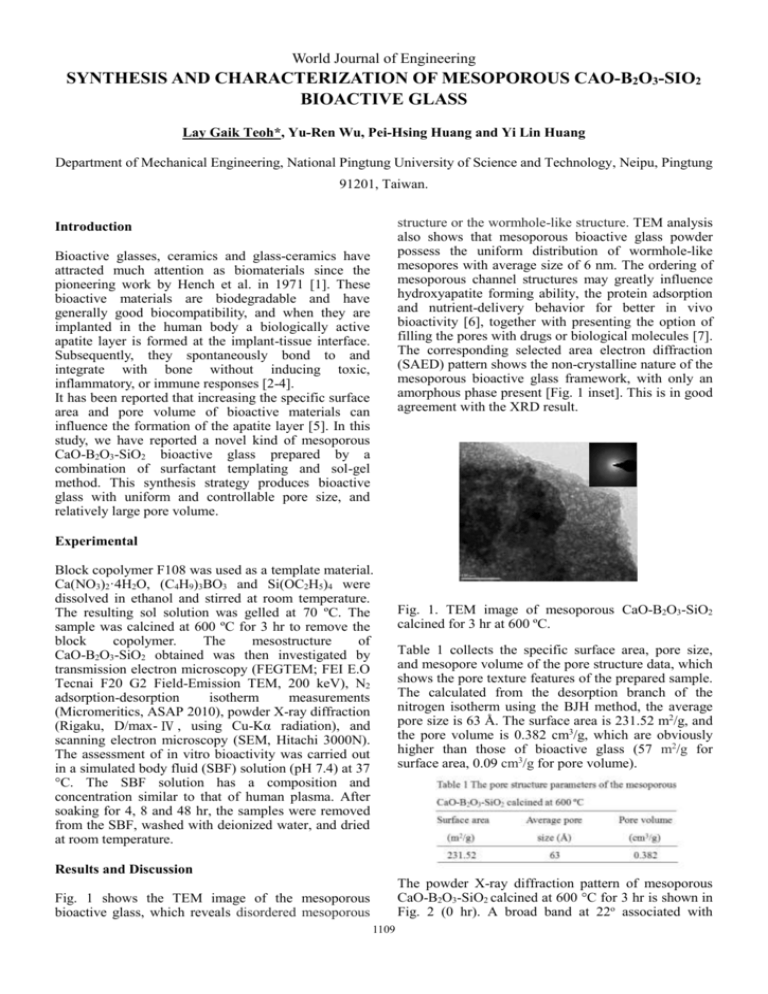
World Journal of Engineering SYNTHESIS AND CHARACTERIZATION OF MESOPOROUS CAO-B2O3-SIO2 BIOACTIVE GLASS Lay Gaik Teoh*, Yu-Ren Wu, Pei-Hsing Huang and Yi Lin Huang Department of Mechanical Engineering, National Pingtung University of Science and Technology, Neipu, Pingtung 91201, Taiwan. structure or the wormhole-like structure. TEM analysis also shows that mesoporous bioactive glass powder possess the uniform distribution of wormhole-like mesopores with average size of 6 nm. The ordering of mesoporous channel structures may greatly influence hydroxyapatite forming ability, the protein adsorption and nutrient-delivery behavior for better in vivo bioactivity [6], together with presenting the option of filling the pores with drugs or biological molecules [7]. The corresponding selected area electron diffraction (SAED) pattern shows the non-crystalline nature of the mesoporous bioactive glass framework, with only an amorphous phase present [Fig. 1 inset]. This is in good agreement with the XRD result. Introduction Bioactive glasses, ceramics and glass-ceramics have attracted much attention as biomaterials since the pioneering work by Hench et al. in 1971 [1]. These bioactive materials are biodegradable and have generally good biocompatibility, and when they are implanted in the human body a biologically active apatite layer is formed at the implant-tissue interface. Subsequently, they spontaneously bond to and integrate with bone without inducing toxic, inflammatory, or immune responses [2-4]. It has been reported that increasing the specific surface area and pore volume of bioactive materials can influence the formation of the apatite layer [5]. In this study, we have reported a novel kind of mesoporous CaO-B2O3-SiO2 bioactive glass prepared by a combination of surfactant templating and sol-gel method. This synthesis strategy produces bioactive glass with uniform and controllable pore size, and relatively large pore volume. Experimental Block copolymer F108 was used as a template material. Ca(NO3)2·4H2O, (C4H9)3BO3 and Si(OC2H5)4 were dissolved in ethanol and stirred at room temperature. The resulting sol solution was gelled at 70 ºC. The sample was calcined at 600 ºC for 3 hr to remove the block copolymer. The mesostructure of CaO-B2O3-SiO2 obtained was then investigated by transmission electron microscopy (FEGTEM; FEI E.O Tecnai F20 G2 Field-Emission TEM, 200 keV), N2 adsorption-desorption isotherm measurements (Micromeritics, ASAP 2010), powder X-ray diffraction (Rigaku, D/max- Ⅳ , using Cu-Kα radiation), and scanning electron microscopy (SEM, Hitachi 3000N). The assessment of in vitro bioactivity was carried out in a simulated body fluid (SBF) solution (pH 7.4) at 37 °C. The SBF solution has a composition and concentration similar to that of human plasma. After soaking for 4, 8 and 48 hr, the samples were removed from the SBF, washed with deionized water, and dried at room temperature. Fig. 1. TEM image of mesoporous CaO-B2O3-SiO2 calcined for 3 hr at 600 ºC. Table 1 collects the specific surface area, pore size, and mesopore volume of the pore structure data, which shows the pore texture features of the prepared sample. The calculated from the desorption branch of the nitrogen isotherm using the BJH method, the average pore size is 63 Å. The surface area is 231.52 m2/g, and the pore volume is 0.382 cm3/g, which are obviously higher than those of bioactive glass (57 m2/g for surface area, 0.09 cm3/g for pore volume). Results and Discussion The powder X-ray diffraction pattern of mesoporous CaO-B2O3-SiO2 calcined at 600 °C for 3 hr is shown in Fig. 2 (0 hr). A broad band at 22o associated with Fig. 1 shows the TEM image of the mesoporous bioactive glass, which reveals disordered mesoporous 1109 World Journal of Engineering (c) amorphous silicate can be noted in XRD pattern of CaO-B2O3-SiO2 bioactive glass and no other diffraction peaks are present, as shown in Fig. 2. It is clear to see that the mesoporous CaO-B2O3-SiO2 sample was still amorphous when calcined at 600 °C. The XRD patterns can be used to evaluate the changes on the mesoporous CaO-B2O3-SiO2 surfaces. The XRD patterns of mesoporous CaO-B2O3-SiO2 after soaking in SBF are shown in Fig. 2. After soaking in SBF for 4, 8 and 48 hr, mesoporous CaO-B2O3-SiO2 revealed several marked peaks, which could be assigned to the (111), (002), (211), (311), (213) and (004) reflection of a hydroxyapatite phase (JCPDS card no. 09-0432). In addition, the broad peaks of hydroxyapatite imply that the deposited hydroxyapatite had a low crystallinity structure. The present study suggests that, mesoporous CaO-B2O3-SiO2 could induce the bonelike hydroxyapatite deposition in SBF, at a preparation temperature that is much lower than that of other CaO-SiO2-based bioactive ceramic powders. Therefore, mesoporous CaO-B2O3-SiO2 might be a more economic reinforcement material for the preparation of bioactive composites. H H (004) (311) H (213) (211) (111) (002) H hydroxyapatite H H 48 hr intensity (arb. units) H Fig. 3. SEM micrographs of mesoporous CaO-B2O3-SiO2 after soaking in SBF for (a) 4, (b) 8, and (c) 48 hr. 8 hr Conclusion Mesoporous CaO-B2O3-SiO2 with high surface area was synthesized using block copolymer as a synthetic template. The high surface area of 231.52 m2/g and the average pore size of 63 Å were derived from a sample prepared under a calcination temperature of 600 °C, which have much higher textural properties than the conventional ones. It can be observed that a layer composed of hydroxyapatite crystallites covered the surface after soaking for 4 hr. These results imply that there are potential applications for this high surface area CaO-B2O3-SiO2 as biomaterial. References 4 hr 0 hr 20 30 40 50 60 70 80 2degrees Fig. 2. XRD patterns of mesoporous CaO-B2O3-SiO2 before and after being soaked in SBF for 4, 8 and 48 hr. The formation of hydroxyapatite deposition was further proved by SEM analysis. Fig. 3 showed that the growth of hydroxyapatite particles was observed after soaking in SBF and the surface of mesoporous CaO-B2O3-SiO2 was covered with hydroxyapatite crystals after soaking for 4, 8 and 48 hr in SBF. The results indicated that mesoporous CaO-B2O3-SiO2 had superior ability to induce hydroxyapatite formation. 1. Hench, L. L., Splinter, R. J., Allen, W. C., and Greenlee, T. K. Bonding mechanism at the interface of ceramics prosthetic materials. J. Biomed. Mater. Res. Symp., 2 (1971) 117-141. 2. Hench, L. L. Bioceramics: From concept to clinic. J. Am. Ceram. Soc., 74 (1991) 1487-1510. 3. Pereira, M. M., Clark, A. E., and Hench, L. L. Calcium phosphate formation on sol-gel-derived bioactive glasses in vitro. J. Biomed. Mater. Res., 28 (1994) 693-698. 4. Vallet-Regi, M., Ramila, A., Padilla, S., and Munoz, B. Bioactive glasses as accelerators of apatite bioactivity. J. Biomed. Mater. Res. Part A, 66A (2003) 580-585. 5. Vallet-Regi, M., Ragel, C. V., and Salinas, A. J. Glasses with medical applications. Eur. J. Inorg. Chem., 6 (2003) 1029-1042. 6. Fan, J., Yu, C. Z., Gao, T., Lei, J., Tian, B. Z., Wang, L. M., Luo, Q., Tu, B., Zhou W. Z., and Zhao, D. Y. Cubic mesoporous silica with large controllable entrance sizes and advanced adsorption properties. Angew. Chem., Int. Ed., 42 (2003) 3146-3150. 7. Slowing, I. I., Trewyn, B. G., Giri, S., and Lin, V. S. Y. Mesoporous silica nanoparticles for drug delivery and biosensing applications. Adv. Funct. Mater., 17 (2007) 1225-1236. (a) (b) 1110
